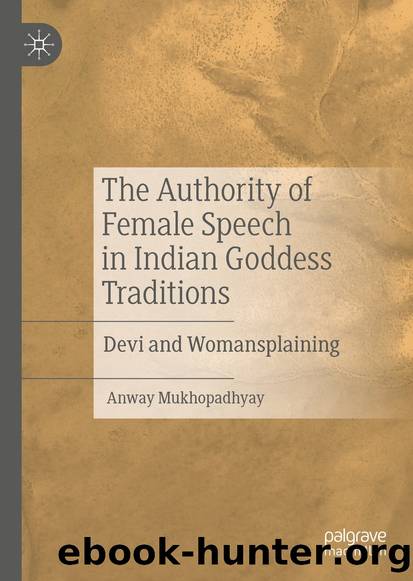The Authority of Female Speech in Indian Goddess Traditions by Anway Mukhopadhyay;

Author:Anway Mukhopadhyay;
Language: eng
Format: azw3, epub, mobi
ISBN: 9783030524555
Publisher: Springer Nature
Published: 2021-04-14T05:31:28.611325+00:00
Vimalananda (2011, 266) goes on to explain and vindicate this maternal figuration of the Absolute by associating the Great Goddess with the human mothers:The first preceptor (Adiguru) of every man is his mother. She is his visible Devata. His first lessons are learnt of her. It is the mark also of the Earth to generate and nourish all Jivas, like a motherâ¦. Hence we are not wrong in saying that the world is full of the Mother.
Here, Mahakali is unequivocally homologized with the human mothers who, as it were, repeat continuously, at the individual level, Kaliâs cosmic function as the âAdiguru of the worldâ. Thus, Devi as doer (the World Mother as the sustainer of the universe) is the same as Devi-as-Speaker (conveyer of knowledge as the maternal Adiguru): her compassion manifests itself through her enlightening function as a divine guru. This is the function in which, according to Vimalananda, the flesh-and-blood mothers, too, participate.
There are a lot of legends of Deviâs maternal concern for her children, on which the practising Shaktas would draw time and again. In these legends, the maternal concerns of Devi-as-guru become prominent. The composite figure of Devi-as-guru-as-mother invoked by Vimalananda, in whom the nourishing/caring and instructing/enlightening functions of the divine feminine overlap, seems to cast her shadow over these legends. Let us look at some such legends now. When Balananda Brahmachari, a great religious personality born in late-nineteenth-century India, visited the Nilachala Hill where the temple of Goddess Kamakhya is situated, he fell ill, suffering from cholera. It is said that, suddenly, a goddess (probably Devi Kamakhya herself) appeared before him and assured him that he would not die, even though she exhorted him to leave that place as soon as possible. Balananda then came round miraculously (Bharati 2013, 226). Here Devi is at once a miracle worker and a nourishing mother who also guides her children on the spiritual path, indicating to them the proper course of action. As Gopinath Kaviraj (2014, 72â73) relates in Jnanaganja , Swami Vishuddhananda Paramahamsa taught him repeatedly that a yogi would never be successful in yoga without the grace of the Divine Mother. The yogi must surrender himself to the Mother and then her divine grace would guide and empower the yogi on the path of yoga. These instances point to the fact that enlightening wisdom is not distanced from but implicated in Deviâs nourishing function and her maternal concerns.
Probing more closely Vishuddhananda Paramahamsaâs focus on the centrality of the Goddessâs grace in yogic sadhana , we come to realize that, in yoga, as well as various other occult practices and experiences, Devi often assumes the form of an inner guru who guides the male subject from within his psyche. In this context, it might be pertinent to refer to an interesting work in Hindi which is generically hybrid, containing mystic drawings and their esoteric explanations related to Kundalini yoga . The author (and painter) of this book, Rakesh Kumar (2015, 5â9), says that these drawings emerged as
Download
The Authority of Female Speech in Indian Goddess Traditions by Anway Mukhopadhyay;.epub
The Authority of Female Speech in Indian Goddess Traditions by Anway Mukhopadhyay;.mobi
This site does not store any files on its server. We only index and link to content provided by other sites. Please contact the content providers to delete copyright contents if any and email us, we'll remove relevant links or contents immediately.
| Africa | Americas |
| Arctic & Antarctica | Asia |
| Australia & Oceania | Europe |
| Middle East | Russia |
| United States | World |
| Ancient Civilizations | Military |
| Historical Study & Educational Resources |
The Dawn of Everything by David Graeber & David Wengrow(1571)
The Bomber Mafia by Malcolm Gladwell(1523)
Facing the Mountain by Daniel James Brown(1431)
Submerged Prehistory by Benjamin Jonathan; & Clive Bonsall & Catriona Pickard & Anders Fischer(1376)
Tip Top by Bill James(1291)
Wandering in Strange Lands by Morgan Jerkins(1283)
Evil Geniuses: The Unmaking of America: A Recent History by Kurt Andersen(1272)
Red Roulette : An Insider's Story of Wealth, Power, Corruption, and Vengeance in Today's China (9781982156176) by Shum Desmond(1267)
The Way of Fire and Ice: The Living Tradition of Norse Paganism by Ryan Smith(1259)
Driving While Brown: Sheriff Joe Arpaio Versus the Latino Resistance by Terry Greene Sterling & Jude Joffe-Block(1232)
American Kompromat by Craig Unger(1214)
F*cking History by The Captain(1197)
It Was All a Lie by Stuart Stevens;(1193)
American Dreams by Unknown(1156)
Treasure Islands: Tax Havens and the Men who Stole the World by Nicholas Shaxson(1153)
Evil Geniuses by Kurt Andersen(1144)
White House Inc. by Dan Alexander(1123)
The First Conspiracy by Brad Meltzer & Josh Mensch(1076)
The Fifteen Biggest Lies about the Economy: And Everything Else the Right Doesn't Want You to Know about Taxes, Jobs, and Corporate America by Joshua Holland(1031)
